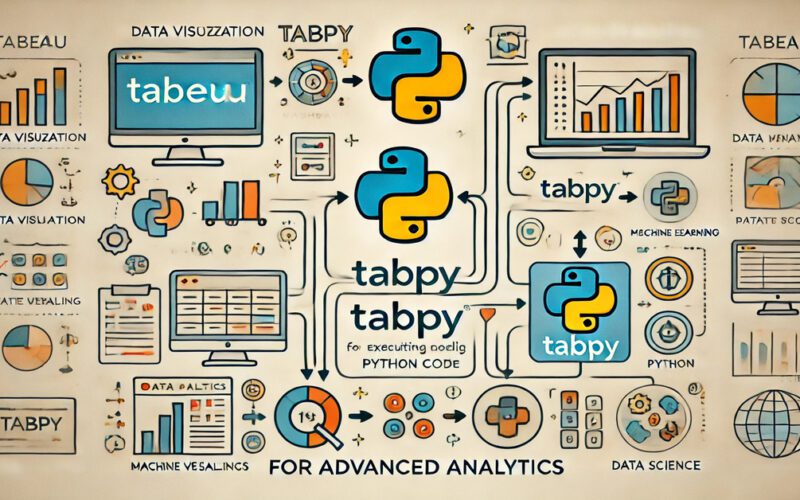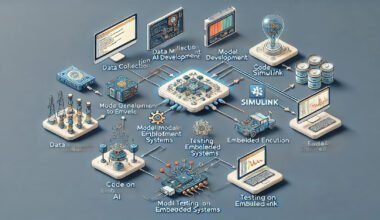Summary: Incorporating TabPy into Tableau allows users to execute Python scripts directly within their dashboards, significantly enhancing analytical capabilities. This integration enables advanced data processing, Machine Learning applications, and real-time calculations, empowering organisations to derive deeper insights and make informed decisions based on complex data analyses.
Introduction
In today’s data-driven landscape, organisations are increasingly looking for ways to enhance their Data Analytics capabilities. One powerful combination is the integration of TabPy (Tableau Python Server) with Tableau, a leading data visualisation tool.
This integration allows users to leverage Python’s advanced analytical capabilities directly within Tableau, enabling more sophisticated data processing and predictive analytics.
Key Takeaways
- TabPy enables Python script execution within Tableau dashboards.
- Integrating TabPy enhances data processing and analytical capabilities.
- Real-time calculations improve user interactivity and experience.
- Machine Learning models can be easily deployed in Tableau.
- organisations can derive deeper insights from complex data analyses.
What is TabPy?
TabPy is an open-source analytics extension that enables Tableau to run Python scripts and functions. By executing Python code remotely, TabPy enhances Tableau’s functionality, allowing users to perform complex calculations, Machine Learning, and statistical analyses that are not natively supported in Tableau.
This capability makes it possible for data analysts and scientists to utilise Python libraries such as Pandas, NumPy, and Scikit-learn within their Tableau dashboards, significantly expanding their analytical toolkit.
Why Use TabPy with Tableau?
Integrating TabPy with Tableau significantly enhances the analytical capabilities of Tableau, allowing users to harness the power of Python for advanced analytics. Here’s a detailed look at why using TabPy with Tableau is beneficial.
Enhanced Analytical Capabilities
TabPy (Tableau Python Server) enables Tableau to execute Python scripts directly within calculated fields. This integration allows users to leverage a vast array of Python libraries, such as Pandas, NumPy, and Scikit-learn, which are essential for data manipulation and Machine Learning tasks.
By using TabPy, organisations can easily implement complex statistical analyses and Machine Learning models that are not natively supported in Tableau.
Dynamic Data Processing
One of the standout features of TabPy is its ability to perform dynamic calculations based on user interactions within Tableau dashboards. For example, when a user filters data or changes parameters, the corresponding Python scripts can be re-executed in real-time, providing updated insights without the need for manual intervention.
This capability enhances the interactivity of dashboards and allows for more responsive data exploration.
Simplified Model Deployment
TabPy allows Data Scientists to develop Machine Learning models in Python and deploy them easily within Tableau. Once a model is published on the TabPy server, it can be accessed via a simple line of Python code in Tableau. This simplifies the process of incorporating complex models into dashboards without requiring users to understand the underlying complexities of the algorithms used14.
Collaboration and Sharing
With TabPy, teams can share their analytical models across departments seamlessly. This feature is particularly useful for organisations with dedicated Data Science teams that develop custom models. By publishing these models on TabPy, other users can leverage them in their analyses without needing extensive programming knowledge.
Setting Up TabPy for Tableau
Setting up TabPy involves several steps:
- Install Python: Ensure that Python is installed on your machine. Download it from the official Python website.
- Install TabPy: Open your command prompt or terminal and run:
Start the TabPy Server: In your command prompt or terminal, type:
- This will start the server on the default port 9004.
- Connect Tableau to TabPy:
- Open Tableau and navigate to Help > Settings and Performance > Manage External Service Connection.
- Select TabPy as the service type and enter localhost for the server name and 9004 for the port.
- Click Test Connection, then apply the settings
Using Python Scripts in Tableau via TabPy
Once connected, you can use Python scripts in your Tableau calculated fields:
- Create a new calculated field in Tableau.
- Use the SCRIPT_REAL, SCRIPT_STR, or other SCRIPT functions depending on your output type.
- Write your Python code directly in the calculation editor. For example:
This script calculates the sum of two fields using Python’s list comprehension
Real-World Use Cases and Examples
The following five real-world use cases of TabPy integrated with Tableau, each demonstrating its powerful capabilities in various industries. For instance, a retail company utilised TabPy to analyse purchasing patterns and predict future sales trends, resulting in a 20% increase in targeted marketing effectiveness. Here are some of the other examples:
E-commerce Sentiment Analysis
E-commerce platforms use TabPy to analyse customer reviews for sentiment. By applying natural language processing (NLP) techniques, businesses can visualise sentiment trends over time, allowing them to address customer concerns and improve product offerings effectively.
Sales Lead Scoring
Companies implement predictive lead scoring using TabPy to rank sales prospects based on engagement data and demographics. This approach helps sales teams focus on high-potential leads, increasing conversion rates and optimising marketing strategies, leading to improved sales performance.
Healthcare Outcome Prediction
Healthcare providers utilise TabPy to build predictive models that assess patient outcomes based on historical health data. By integrating these models into Tableau dashboards, clinicians can make informed decisions about treatment plans, enhancing patient care and operational efficiency.
Dynamic Customer Segmentation
Retailers employ TabPy for dynamic clustering of customer data, enabling real-time segmentation based on purchasing behaviour. This allows businesses to tailor marketing campaigns effectively and improve customer engagement by targeting specific segments with personalised offers.
Churn Prediction for Subscription Services
Subscription-based companies leverage TabPy to predict customer churn by analyzing usage patterns and engagement metrics. By identifying at-risk customers early, businesses can implement targeted retention strategies, significantly reducing churn rates and increasing customer lifetime value.
Best Practices for Using TabPy with Tableau
To maximise the benefits of using TabPy with Tableau, consider the following best practices. By following these best practices, organisations can fully leverage the capabilities of TabPy within Tableau, enhancing their analytical power and improving decision-making processes.
Optimise Scripts
Ensure your Python scripts are efficient and well-structured. This minimises latency in dashboard performance, allowing for quicker data processing and visualisation. Efficient scripts can significantly enhance user experience by reducing wait times when interacting with dashboards.
Limit Data Size
Use sampling techniques or filter data before sending it to TabPy. By limiting the amount of data processed, you can reduce processing time and improve performance. This practice is especially important when working with large datasets, as it helps maintain responsiveness in Tableau visualisations.
Implement Error Handling
Incorporate robust error handling within your Python scripts to manage unexpected inputs or failures gracefully. This ensures that your Tableau dashboards remain functional even when errors occur, providing users with a seamless experience and preventing crashes or misleading results.
Leverage Published Models
Consider publishing your Machine Learning models on TabPy for reuse across different Tableau dashboards. This approach simplifies maintenance and allows users to access complex models without needing to understand the underlying code, fostering collaboration between Data Scientists and business users.
Monitor Performance
Regularly monitor the performance of your TabPy integration. Use Tableau’s built-in performance recording tools to identify bottlenecks and optimise both your Python scripts and Tableau configurations accordingly. Keeping an eye on performance metrics helps ensure that your analytics remain efficient and effective over time.
Challenges and Considerations of Using TabPy into Tableau
Using TabPy with Tableau offers many advantages, but it also comes with several challenges that organisations need to consider. Here are some of the key challenges associated with this integration:
Performance Issues with Large Datasets
Processing large datasets through TabPy can lead to performance bottlenecks. Since requests are handled serially, the time taken for computations can increase significantly as the dataset size grows. This can result in slow dashboard performance and a poor user experience, particularly when multiple filters or parameters are applied simultaneously.
Network Throughput Limitations
The throughput of network requests can be a limiting factor when using TabPy. If the network bandwidth is insufficient, it can slow down the communication between Tableau and the TabPy server, leading to delays in data processing and visualisation updates. Organisations may need to invest in better network infrastructure to mitigate this issue.
Complexity of Error Handling
Implementing error handling in Python scripts can be complex, especially for users who may not have extensive programming experience. Without robust error management, unexpected inputs or failures can cause dashboards to crash or return misleading results. Ensuring that scripts handle errors gracefully is crucial for maintaining reliability.
Dependency Management
Managing dependencies for Python libraries used in TabPy can be challenging. Organisations must ensure that all required libraries are installed and compatible with the TabPy environment. Conflicts between library versions or missing dependencies can lead to script failures, complicating the integration process.
Limited Support for Asynchronous Processing
TabPy does not natively support asynchronous requests, which means that all requests are processed one at a time. This limitation can hinder performance when multiple users interact with dashboards simultaneously, as each request must wait for the previous one to complete. Organisations may need to explore workarounds or consider alternative architectures to improve responsiveness.
Future Trends
The following trends indicate a promising future for the integration with Tableau, enhancing its capabilities and making it an even more powerful tool for advanced analytics.
Enhanced Machine Learning Integration
Future developments in TabPy are expected to provide deeper integration with Machine Learning frameworks, enabling users to deploy complex models seamlessly within Tableau. This will facilitate advanced analytics scenarios, allowing business users to leverage predictive insights directly from their dashboards without needing extensive programming knowledge or Data Science expertise.
Improved Security Features
As organisations prioritise data security, upcoming updates for TabPy will likely focus on enhancing security protocols. This may include features such as secure connections via HTTPS, improved authentication methods, and detailed logging capabilities, ensuring that sensitive data processed through Python scripts remains protected and compliant with regulatory standards.
Real-Time Analytics Capabilities
The future of TabPy integration will emphasise real-time analytics, allowing Python scripts to execute dynamically as users interact with Tableau dashboards. This enhancement will provide immediate feedback and insights, significantly improving user experience and enabling more interactive data exploration, ultimately leading to faster and more informed decision-making processes.
Integrating TabPy with Tableau unlocks advanced analytics capabilities, enabling organisations to leverage Python’s powerful data processing and Machine Learning functionalities directly within their visualisations. By embracing this integration, businesses can enhance decision-making, improve operational efficiency, and drive deeper insights from their data, ultimately fostering a more data-driven culture.
Frequently Asked Questions
What is Tabpy and How Does it Work with Tableau?
TabPy (Tableau Python Server) is an analytics extension that allows Tableau to execute Python scripts. It facilitates advanced analytics by enabling users to run complex calculations and Machine Learning models directly within Tableau dashboards, enhancing data visualisation capabilities and providing deeper insights.
What are the Key Benefits of Using Tabpy with Tableau?
Using TabPy with Tableau offers several benefits, including advanced analytics capabilities, dynamic calculations based on user interactions, and the ability to leverage Python libraries for data manipulation. This integration empowers organisations to perform sophisticated analyses and improve decision-making processes through enhanced data visualisation.
Are There Any Limitations When Using Tabpy with Tableau?
Yes, some limitations include potential performance issues with large datasets, network throughput constraints, and the complexity of error handling in Python scripts. Additionally, TabPy does not natively support asynchronous processing, which can affect responsiveness when multiple users interact with dashboards simultaneously.




